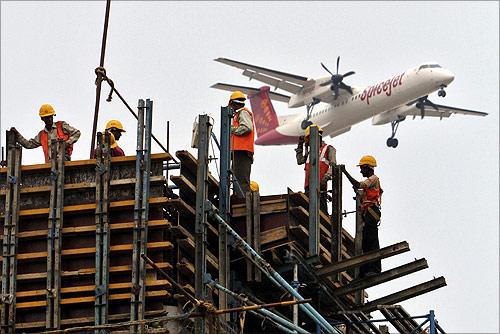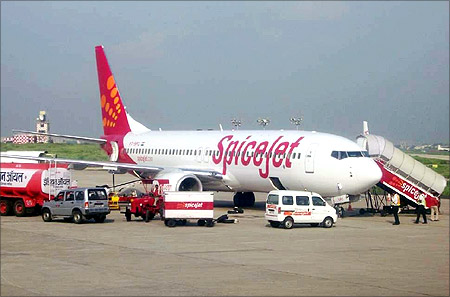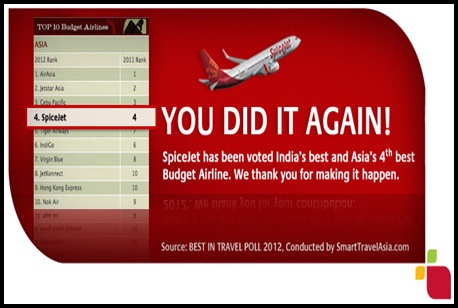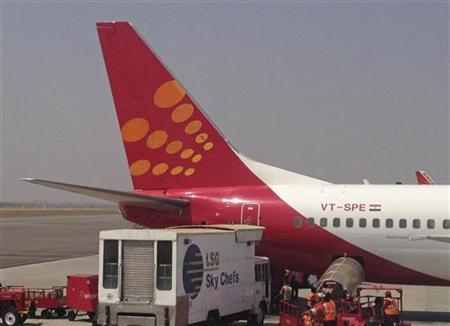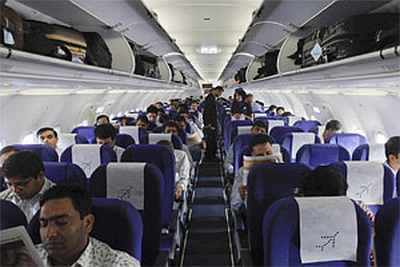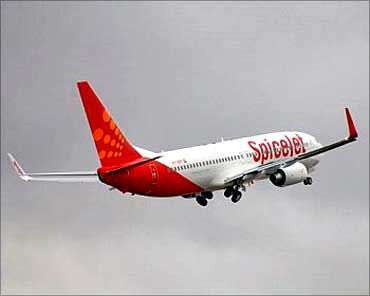 | « Back to article | Print this article |
How Neil Mills plans to make SpiceJet profitable
When SpiceJet decided to fly thrice a week from Delhi to war-torn Kabul last month, many thought it was a recipe for disaster.
But, for Neil Mills, the soft-spoken CEO of the airline, who had previously strategised for international low-cost carriers (LCCs), such as EasyJet and flydubai, there was a method in his madness.
Mills was cashing in on the fact that only three airlines - Air India and two other small carriers - flew this route.
Yet, medical tourism traffic from Kabul into India has been booming and so has trade between the two countries.
And, because of the supply constraint, airlines were charging stiff fares - Rs 10,000 to as much as Rs 29,000 for a one-way flight that took just two hours - making it one of the most profitable routes from India, with a yield per passenger kilometre that was double of what it would be if you flew to Dubai or Singapore. So, for Mills, it was a no-brainer.
Click NEXT to read more...
How Neil Mills plans to make SpiceJet profitable
"Afghani carriers are panicky because we have been successful. Apart from Air India, we are the only other airline classified as a safe carrier," says a satisfied-looking Mills.
<B>The contrarian</B><BR>
Nearly two years after taking over the reins at SpiceJet, Mills has been rewriting the rules of the LCC game.
In international skies, unlike most others, he has not followed the beaten path of flying only into safe routes - where it is easy to both set up operations and get passengers - like Singapore or Kuala Lumpur, though the carrier flies to Dubai.
The catch here is that these routes represent eroded margins, due to cut-throat competition from day one, thanks to too many players chasing the same routes.
Click NEXT to read more...
How Neil Mills plans to make SpiceJet profitable
Instead, Mills is looking at routes where he will have a first-mover advantage, where there are not too many players, and where setting up operations and getting permission, due to tough bilateral rules, is a challenge.
So, next on his agenda is to fly to Guangzhou in China, Riyadh in Saudi Arabia, and perhaps, Hong Kong.
In the domestic skies, Mills wants to once again turn the model upside down. Here, he wants to grab first- mover advantage by connecting smaller towns and cities with multiple metros and larger cities, where no one flies at the moment.
Click NEXT to read more...
How Neil Mills plans to make SpiceJet profitable
To do that, he has gambled, by acquiring the 78- seater Bombardier Q400. With a fleet of 12 Bombardiers, which fly 12 hours a day, he already connects 16 destinations, including Jabalpur and Amritsar, as well as Hubli and Tirupati, among others.
Mills has also connected the smaller cities to larger ones.
So, Hubli now has connectivity to Hyderabad and Bangalore, as well as to Chennai. And, after just a year in service, the regional jet network is already a force to reckon with - it constitutes one-third of its over 300 flights a day and nearly 20 per cent of its passengers.
Click NEXT to read more...
How Neil Mills plans to make SpiceJet profitable
<B>Point-to-point</B><BR>
Of course, erstwhile Air Deccan also tried a similar strategy, but did not succeed. Mills says his strategy is different - he is not looking at a hub-and-spoke connectivity. For instance, his flight from Dehradun is not meant as connectivity for a passenger to Mumbai via Delhi, where the Bombardier flight's time is synchronised with that of a Boeing Delhi-Mumbai flight.
"We are looking at point-to-point connectivity. If we synergise the two operations for hub and spoke, then utilisation of both will suffer," he says.
But for Mills, the regional jet network is key to expanding passenger base. He says currently, there are only 36 airports where you can fly narrow-bodied aircaft. But, with smaller jets, that number goes up to 96.
Click NEXT to read more...
How Neil Mills plans to make SpiceJet profitable
"How many times can you fly to these 36 airports? You need to grow the market," he argues. So far, his strategy seems to be paying off. For the first time in five quarters, SpiceJet made a net profit, of Rs 56 crore.
<B>Flight risks</B><BR>
Experts, however, say that the strategy comes with some serious risks until, of course, Mills pulls it off. "By having two different kinds of aircraft, you are virtually running two LCCs," says Kapil Kaul, who heads the Centre for Asia Pacific Aviation (CAPA) in India.
"This obviously has an impact on your costs, as you will require a different set of expertise. That is why, say IndiGo, has not gone for it".
Click NEXT to read more...
How Neil Mills plans to make SpiceJet profitable
Also, a slight change in policy could wreck the strategy. For instance, the airport regulator in May allowed the Delhi airport to impose Rs 10,000 as landing and parking charges on each aircraft which had less than 80 seats, overturning an earlier policy where they were exempted from any payment.
This decision, together with the huge rise in user development fee on passengers in Delhi, has impelled SpiceJet to delay bringing in three more Bombardiers and add four-five new destinations in North India. Mills says that the new charges would make the ticket prices too high and unviable.
Click NEXT to read more...
How Neil Mills plans to make SpiceJet profitable
The other obvious challenge is that the first-mover advantage is only limited to a few months or a year, till others jump on the bandwagon.
Even Mills acknowledges that, but says that at least in the last 12 months, no other competing player has ordered smaller aircraft to take them on in the regional domestic market.
Aviation watchers say that SpiceJet, which made losses last year, has had to innovate in order to improve its margins and yields, as it is not the market leader in the LCC space.
Click NEXT to read more...
How Neil Mills plans to make SpiceJet profitable
The last financial year, it made losses of around Rs 600 crore, which translates into about Rs 500 on every ticket that it sold, as it picked up 12 million passengers.
On the other hand, market leader IndiGo has been making money and is the king, with a large share in most of the key standard routes (it has a market share of 27.6 per cent, compared to SpiceJet's 18.5 per cent)
"Rather than battling directly with the profitable IndiGo on international and domestic routes head-on, and following a similar strategy, Mills is banking on innovative alternative routes, which are difficult to set up but where you have at least six months to one year of a head start," says a senior executive of a travel company.
Click NEXT to read more...
How Neil Mills plans to make SpiceJet profitable
International play
That is what Mills is doing in the international arena, too. For instance, he wants to fly to Riyadh, where getting permission to fly, he admits, is not that easy. Saudi Arabia is a country where bilaterals are restricted.
"There is only one flight, Saudia, but no Indian carrier. But, Riyadh has a big connection with Muslims in India - with large movement of labour and many big contracts won by Indian companies," says Mills. However, everyone currently goes to the city through Dubai.
Mills' attempt to also fly to Hong Kong on a narrow-bodied aircraft for over five hours, however, is again understandable as there are not too many flights connecting the two countries. But Kaul has a word of caution.
Click NEXT to read more...
How Neil Mills plans to make SpiceJet profitable
"I have doubts whether it is economically viable to run a flight of over five hours on a narrow-bodied aircraft," he says .
Mills is also trying to reduce costs; his will be the first private airline to import aviation turbine fuel (ATF) directly, which he hopes will save some costs. But, his detractors say that the logistics required for transportation from the Chennai airport, where the imported ATF will come, is too complicated and not worth the minor saving. Mills doesn't agree.
"Last year, we spent Rs 2,200 crore on fuel. Even if we save one per cent, it is Rs 20 crore for our shareholders". The question is, whether his new strategy will deliver his shareholders the goods.

